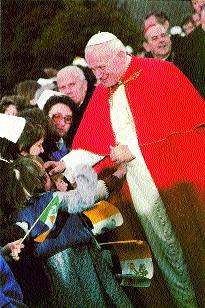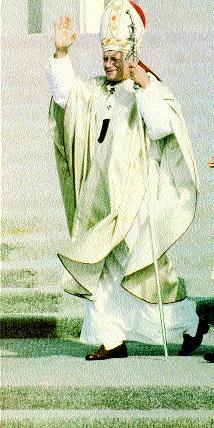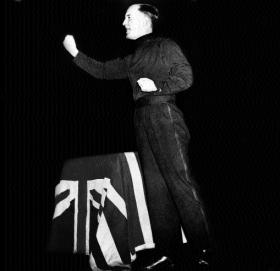TV eye
Published in Early Modern History (1500–1700), Issue 2 (Mar/Apr 2005), Reviews, Volume 13
Oliver Cromwell, a minor and fairly impoverished country gentleman; his superb military ability was combined with an unshakeable conviction that he was God’s instrument in English history. (National Portrait Gallery, London)
Our incurably violent neighbour
Channel Four
Blood on our hands: the English Civil War, 10 Feb. 2005
Directed by Tim Kirby for Mentorn Oxford
Oliver Cromwell: New Model Englishman, 12 Feb. 2005
Directed by Paul Sen for Wall to Wall Television
by Eamon O’Flaherty
In recent years Channel Four has produced some very good programming on seventeenth-century British history, including a fine series on the Great Fire of London and the Plague of 1666. The recent Channel Four series on the English Civil War included two interesting documentaries that took quite different approaches to the great crisis of the British state of the 1640s. Blood on our hands approached the Civil War through the perspective of minor figures who were caught up in the conflict and left behind diaries and letters reflecting on their experience. Oliver Cromwell: New Model Englishman (first broadcast in 2001) took a different, more traditional perspective by focusing on the military and political leader who dominated events and imposed his will on the three Stuart kingdoms: defeating Charles I, abolishing the monarchy, and conquering Ireland and Scotland. Both films had a distinguished cast of experts, including Irish historians Mícheál Ó Siochrú and Tom Reilly. Pride of place in both productions went to Ronald Hutton, not just for his elegant waistcoats, flowing ties and Bunyanesque hair, but also for his elegant connecting narrative and for the sharpness of his historical assessments.
One difficulty with interpreting or explaining the Civil Wars lies in the complexity of their origins and the often-bewildering shifts in the military and political balance of forces. The director of Blood on our hands addressed this problem by emphasising the human reality of the war as it affected individuals in the period. Accordingly much of the film consisted of extracts from the writings of contemporaries like Brilliana Harley, wife of Edward Harley, a Puritan country gentleman from Hereford who fought on the parliamentary side. Like many of the English gentry, the Harleys were deeply influenced by Puritanism and united in their dislike and suspicion of the religious reforms carried out by Charles I and his archbishop of Canterbury, William Laud. Charles I’s unfortunate attempt to extend these reforms to Scotland led to war and the need to summon parliament in England, precipitating a showdown between parliament and the king that culminated in civil war. Blood on our hands explored the human side of the drift into war of a country that had been at peace with itself for generations. This cut into the time available for exploring the larger repercussions of the conflict but brought us face to face with the direct experience of ordinary people, including a Puritan cabinet-maker from London, a parliamentary soldier and an Oxford schoolboy.
The war itself was a radicalising experience for the participants. Hardly anybody in England in 1642 could have foreseen the revolutionary consequences of the conflict. The wars also took place against a background of unprecedented levels of violence in the Thirty Years’ War in Europe, raging since 1618.

Scene from a battle re-enactment in Blood on our hands. (Channel Four Stills Library )
The royalist military leader Prince Rupert of the Rhine introduced Continental methods of warfare from Germany into England. Puritan iconoclasm, the sieges and sacking of towns, and the bitterness engendered by the sense of religious crusade all played their part in ensuring that the civil wars were a particularly bloody episode in British and Irish history. Some estimates claim that the loss of life was proportionately greater than that suffered in the First World War, although the proportions of losses in Ireland and Scotland were certainly greater.
Cromwell’s role in the conflict and its outcome was central, as Oliver Cromwell: New Model Englishman showed to great effect. As a military commander Cromwell ensured that the parliamentary forces regrouped from their disastrous showing in the early part of the conflict. A minor and fairly impoverished country gentleman, Cromwell’s superb military ability was combined with an unshakeable conviction that he was God’s instrument in English history. Cromwell’s road to the republic was, nevertheless, a slow one. Even after the king’s surrender in 1646, it took three years and a second civil war before he was convinced of the need for the abolition of the monarchy and the execution of Charles I in 1649. By this stage Cromwell was at the head of an army that was a hotbed of radical religion and politics. The Putney debates of 1647, when Cromwell and other leaders were faced with demands for a political revolution by radical officers, were particularly well handled. Charles’s duplicity and Cromwell’s remarkable tactical ability in politics as well as in war are central to the momentous decision to abolish the monarchy and establish an English republic. Not least of the ironies involved was the declining role of parliament after the king’s defeat. Already purged by the army, the ‘rump’ parliament was dismissed by Cromwell in 1653. England under the Lord Protector was to some extent a military dictatorship. The disaffection of many of those who supported parliament against the king was a clear indication of the limits of the revolution. After Cromwell’s death in 1658 the republic’s days were numbered, and Charles II’s restoration in 1660 was welcomed by many of the parliamentary gentry who had fought against his father.

Charles I—his duplicity was central to the momentous decision to abolish the monarchy and establish an English republic. (National Portrait Gallery, London )
The Channel Four series focused on the Civil War primarily as an English phenomenon. This is interesting, given the enormous investment in ‘the new British history’ in recent years. Although many Irish readers will find the term objectionable, the new British history sought to redress the imbalance of an Anglocentric approach to the history of these islands by creating a more inclusive history in which the part played by Wales, Scotland and Ireland received due attention. It may be argued that the new British history was not so new in Scotland and Ireland, and further that the project always meant many different things to different people. Certainly Scottish and Irish historians have always been aware of the importance of these interactions, not least with what one Scottish historian called ‘Scotland’s incurably violent southern neighbour’. David Starkey’s recent television history of the English monarchy was, by contrast, an unashamedly English narrative. The Channel Four Civil War series was much more wide-ranging, but once again the Irish and Scottish aspects of the civil wars and revolution of the mid-seventeenth century were marginalised. Irish and Scottish realities only figure when, as in 1641 or 1650, they impinge on the narrative of English history. This poses a real challenge to film-makers and historians alike. Is it possible to construct a narrative of this period that integrates the history of the three kingdoms at this critical time in their conjoined histories, or are we still marooned in parallel and mutually uncomprehending national histories?
Eamon O’Flaherty lectures in history at University College Dublin.
















